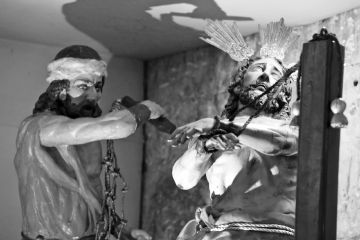
LENTEN EXHIBIT: Life-size images of the passion and death of Christ are on display for
veneration at the Cebu Archdiocesan Museum in Cebu City. The image is part of the Lenten exhibit by renowned
iconographer
Louie Nacorda.
Images of Christ’s passion and death
For centuries, the procession of the pasos in the Philippines has become part of the rich tradition of Holy Week.
From a tableaux of Jesus’ last supper with His apostles to an image of the dead Christ lying in repose – all are brought out to depict the passion and death of the Lord.
But with the passing of time, have people fully understood the meaning behind the images or simply identify the personalities involved in the story of redemption?
Heritage enthusiast and renowned Cebuano iconographer Clodoveo “Louie” Nacorda saw the need to revisit the tradition of the pasos, or the religious images that portrays Jesus’ final hours on earth.
“We want to make sure we know what we are doing. The pasos is not meant to show off what we’ve got or to compete with owners of other sacred images.
The primary purpose of the pasos is to help us visualize the passion and death of our Lord,” he said during his lecture on the popular Filipino Lenten tradition at the Archdiocesan Museum of Cebu on Saturday.
“The pasos is designed to move the faithful to contemplation and piety. It is supposed to touch people’s hearts; that when they see those images, they should feel sorry for their sins and be drawn to repentance,” he added.
Inventory of pasos
Derived from the Spanish word paso or step, the pasos procession takes the faithful back to Jesus’ ultimate sacrifice to save mankind over 2,000 years ago.
In the Philippines, Nacorda said the St. Augustine Parish Church in Baliuag, Bulacan probably has the most number of pasos tableaux which now stands at 104.
“The number just keeps on growing. A few years back, they had 84. Now, their pasos tableaux has increased to 104,” he said.
In Cebu, the Saints Peter and Paul Parish of Bantayan town on Bantayan Island has the biggest number of religious images and tableaux depicting the passion and death of Jesus.
The original processional images were listed by former parish priest Fr. Leoncio Aguilar in the June 1887 inventory which can still be perused in the parish’s archives.
At present, 33 heirloom images and tableaux of the passion of Jesus Christ are brought out during the Good Friday procession in Bantayan town.
Also popular for their pasos images in Cebu are the National Shrine of St. Joseph in Mandaue City, the Cebu Metropolitan Cathedral, the Archdiocesan Shrine of St. Catherine of Alexandria in Carcar City, and the St. Francis of Assisi Parish in Balamban town.
The tableaux
The common passion tableaux include the last supper, the agony in the garden of Gethsamane, Jesus’ arrest and trial before Pontius Pilate, the scourging at the pillar, the crowning of thorns, the carrying of the cross, the crucifixion, and the burial of Jesus.
Another image which not all parishes possess is the Señor Desmayo, which depicts how Jesus fainted after He was whipped 39 or 40 times.
According to the Jewish law, Nacorda said a person who was to be scourged must receive not more than 40 lashes.
A “whip of mercy” brings down the number to 39.
According to records, a Roman scourge has three leather ropes attached to a wood handle. On each length of the rope, there would be a number of bone pieces attached at intervals of every three inches.
With the sharp edges, the bones cut deeply into anybody’s skin, shredding their flesh.
To be concluded